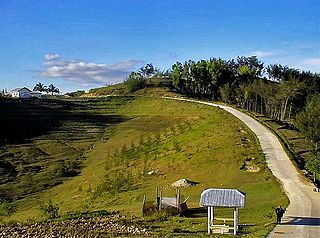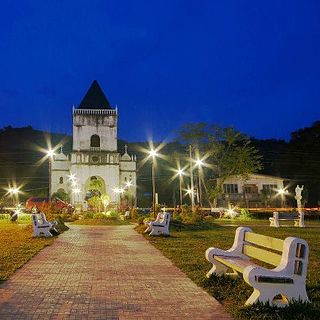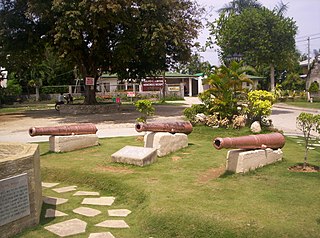
Alcoy, officially the Municipality of Alcoy, is a 5th class municipality in the province of Cebu, Philippines. According to the 2020 census, it has a population of 19,186 people.

Bindoy, officially the Municipality of Bindoy, is a 3rd class municipality in the province of Negros Oriental, Philippines. According to the 2020 census, it has a population of 40,308 people.

Dauin, officially the Municipality of Dauin is a 4th class municipality in the province of Negros Oriental, Philippines. According to the 2020 census, it has a population of 30,018 people.

Guihulngan, officially the City of Guihulngan, is a 5th class component city in the province of Negros Oriental, Philippines. According to the 2020 census, it has a population of 102,656 people, the third-most populous city in Negros Oriental after the cities of Dumaguete and Bayawan. Guihulngan is also dubbed by its residents as the "rising city of the north".

Manjuyod, officially the Municipality of Manjuyod, is a 2nd class municipality in the province of Negros Oriental, Philippines. According to the 2020 census, it has a population of 44,799 people.

San Jose, officially the Municipality of San Jose, is a 5th class municipality in the province of Negros Oriental, Philippines. According to the 2020 census, it has a population of 21,956 people. It is the least populous town in Negros Oriental.

Santa Catalina, officially the Municipality of Santa Catalina, is a 1st class municipality in the province of Negros Oriental, Philippines. According to the 2020 census, it has a population of 77,501 people.

Sibulan, officially the Municipality of Sibulan, is a second class municipality in the province of Negros Oriental, Philippines. According to the 2020 census, it has a population of 64,343 people.

Alcantara, officially the Municipality of Alcantara, is a 5th class municipality in the province of Cebu, Philippines. According to the 2020 census, it has a population of 16,910 people.

Alegria, officially the Municipality of Alegria, is a 4th class municipality in the province of Cebu, Philippines. According to the 2020 census, it has a population of 25,620 people.

Argao, officially the Municipality of Argao, is a 1st class municipality in the province of Cebu, Philippines. According to the 2020 census, it has a population of 78,187 people.

Badian, officially the Municipality of Badian, is a 3rd class municipality in the province of Cebu, Philippines. According to the 2020 census, it has a population of 43,735 people.

Borbon, officially the Municipality of Borbon, is a 4th class municipality in the province of Cebu, Philippines. According to the 2020 census, it has a population of 38,187 people.

Dalaguete, officially the Municipality of Dalaguete, is a 1st class municipality in the province of Cebu, Philippines. According to the 2020 census, it has a population of 74,596 people.

Ginatilan, officially the Municipality of Ginatilan, is a 5th class municipality in the province of Cebu, Philippines. According to the 2020 census, it has a population of 16,906 people.

Ronda, officially the Municipality of Ronda, is a 5th class municipality in the province of Cebu, Philippines. According to the 2020 census, it has a population of 21,005 people.

Sibonga, officially the Municipality of Sibonga, is a 3rd class municipality in the province of Cebu, Philippines. According to the 2020 census, it has a population of 53,424 people.

Tuburan, officially the Municipality of Tuburan, is a 2nd class municipality in the province of Cebu, Philippines. According to the 2020 census, it has a population of 68,167 people.

Bato, officially the Municipality of Bato, is a 4th class municipality in the province of Leyte, Philippines. According to the 2020 census, it has a population of 38,505 people.

Isabel, officially the Municipality of Isabel, is a 1st class municipality in the province of Leyte, Philippines. According to the 2020 census, it has a population of 46,781 people.

























